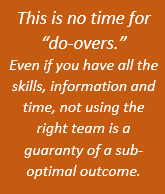When I joined Corum last November, I was told, “We use a team-selling approach to get the best possible outcome for our clients.” While I understood the words, I had no idea of what they really meant until I had participated in a few deals.
Definition of team -- A group of people with a full set of complementary skills required to complete a task, job, or project.
Having the right people was a priority while you were building your company, but you didn’t get it right, right away, did you? The same principle holds true for the set of complementary skills required to get your transaction to close. The fact of the matter is that decisions relating to your M&A transaction are some of the most important ones you will ever have to make. On top of that, you only get to present your company to the market – for the first time – once.
 To optimize the outcome of your M&A transaction you need to build your team ahead of time. That means choosing an M&A advisor, legal advisor and financial advisor that are all well-versed in transactions in your particular industry. Choosing any of these advisors incorrectly can lead to a deal disaster (whether a good deal falls through or you can’t get close to your Optimal Outcome). Some business owners decide to go it alone or use their neighbor as an all-in-one advisor. In this industry, those are some of the worst ways you can go because you can wind up with a deal amount that isn’t anywhere near what your valuation suggested or what your stakeholders want.
To optimize the outcome of your M&A transaction you need to build your team ahead of time. That means choosing an M&A advisor, legal advisor and financial advisor that are all well-versed in transactions in your particular industry. Choosing any of these advisors incorrectly can lead to a deal disaster (whether a good deal falls through or you can’t get close to your Optimal Outcome). Some business owners decide to go it alone or use their neighbor as an all-in-one advisor. In this industry, those are some of the worst ways you can go because you can wind up with a deal amount that isn’t anywhere near what your valuation suggested or what your stakeholders want.
When it comes to your M&A advisor, you shouldn’t pick just a single person or only a couple of people. To get the best outcome you need the best team, composed of experts with complementary skills and backed by the best information. Here’s what you are going to need:
- Senior dealmakers (more than one) – These are the people that are going to be negotiating the deal on your behalf. This is no place or time for lightweights and inexperienced individuals. You don’t want to try to find that one guy that did a deal similar to yours in the last year.
- Researchers – This team will be able to understand your buyer community and to identify and clarify strategic fit. Sometimes the buyers themselves don’t understand the strategic fit until it is put under their noses. In today’s global M&A environment, researchers need access to a well-maintained global database of buyers.
- Valuation experts – Traditional, tangible asset-based companies are easier to value than today’s intangible asset-based technology companies. Without fully understanding the valuation of your company, you may well be leaving money on the table.
- Professional writers – If you are trying to promote interest in your company from buyers, you have to present them with an interesting and compelling story. This is not about selling a product, it is about selling your company. There is a significant difference, but a great writer will ensure that your story is told well in your executive summary.
There are many groups out there that can help you navigate your M&A experience, but there are none that have Corum’s team-selling approach. The team is an integral part of Corum’s 8-step M&A process, honed after 33 years of sell-side, technology dealmaking.
Our dealmakers are all former CEOs that have been through the process with their own companies (some of them have done this multiple times). They have the experience and knowledge to inject a level of seriousness and urgency in the buyers’ minds. They work with the buyer community all day, every day. They understand what buyers are looking for, how they like to have material presented to them, and what the buyers’ internal M&A processes.
On the research front, you cannot build a buyer list just using LinkedIn and Google searches. Our research teams in the US and Europe rely on the accumulated data of thousands of transactions to assemble the best buyer list possible for each individual seller. Over 250 of these transactions are ones that Corum has completed – more than anyone else in the world with respect to software and IT companies. It’s not just about having the people doing the research – the database is also a member of your team. It is all about the breadth and depth of your data in today’s global M&A environment.
Corum, literally, wrote the book on valuing software and technology companies. First published by Wiley & Co. in 1999, the Handbook of Business Valuation is still the definitive source of valuation information for colleges and universities around the globe. A valuation is not all about the numbers. Ascribing value to the many intangibles in technology companies is hugely important. Our valuation team does this every day. There is no dilution of focus – Corum only works with software and tech companies, constantly refining our approach to what value different intangibles can provide a unique company.
Corum employs a team of writers and has developed specific methods for deploying each company’s selling documents. We use large teams, sometimes over 20 people from around the world, to extract the valuable nuggets in your business and ensure that they are presented in a compelling manner to the buyers.

All of this is what it means to work with a team on your M&A transaction to reach an optimal outcome.
Reflecting on my short few months at Corum, I have to say that this team is like no other I have worked with since my days in the Air Force in southern Africa. M&A transactions are a lot like going into battle – the better prepared you are, the more information you have and the higher the caliber of people and weapons on your side, the better the outcome is likely to be. Having a whole team of experts like the ones I’ve met at Corum is the surest way to getting an Optimal Outcome.
